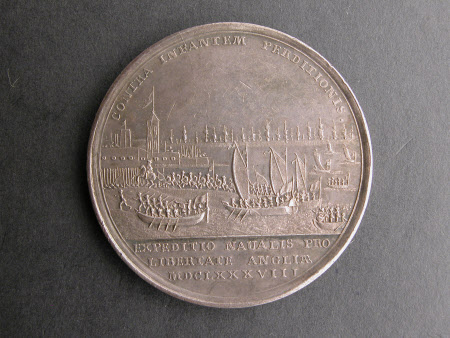The landing of William of Orange at Torbay
Regnier Arondeaux (fl.1678 - 1702)
Category
Coins and medals
Date
1688
Materials
Silver
Measurements
50 mm (Diameter)
Place of origin
Netherlands
Order this imageCollection
Osterley Park and House, London
NT 773274
Summary
Silver, medal commemorating the landing of King William III (1650 - 1702) at Torbay, by Regnier Arondeaux (active 1678 - 1702), Netherlands, 1688. A silver medal by Regnier Arondeaux commemorating the landing of King William III at Torbay in November 1688. On the obverse, the monarch, dressed as a Roman emperor and with a sword in his right hand, trampling with his feet the serpent of discord. He stands before Britannia wearing a triple crown, whose hand he clasps above a burning altar. To the right the armorial shield of Britain is fastened to an orange tree entwined with roses and thistles. In the distance at left, King James and Father Petre flee, the latter carrying Prince James. A rising sun, symbolising hope. Latin legend translates as: ‘God our Protector, Justice our Companion’. The artist’s initials R.A.F. on exergue at left. On reverse, boats are seen landing troops near to a fortified harbour; a fleet of ships in the distance. Main legend reads in translation ‘Against the child of Perdition’ and, in the exergue, ‘The naval expedition for the liberty of England, 1688’.
Full description
The medal commemorates the landing of William of Orange at Brixham in Torbay on 5 November 1688, with an invasion force of 14,000 troops. William had been invited by a group of powerful English Protestant figures to usurp the British throne, basing his claim on the right of succession of his wife, Mary, daughter of King James II/VII. The political crisis which led to the invasion, known as the Glorious Revolution, stemmed ultimately from the conversion to Catholicism of King James in the early 1670s, when he was still Duke of York. James had in 1673 married the Catholic Maria Beatrice Anna Margherita Isabella d’Este (Mary of Modena, 1658-1718). On the death of Charles II in February 1685, James had succeeded and been crowned as king, but his attempts to encourage equal status for the English and Catholic churches had met increasing opposition. It was the birth to James and Mary on 10 June 1688 of a male heir, James Francis Edward Stuart (‘The Old Pretender’, 1688-1766), that set in motion the decision of William of Orange, the king’s son-in-law, to invade. Although James made frantic attempts to reverse his previous pro-Catholic policies, it gradually became clearer that his position was likely to become untenable, and on 10 December the Queen and her son escaped from London in disguise and made their way to exile in France. King James followed her on 18 December. The medal was originally issued with a reverse showing the King’s close advisor the Jesuit Sir Edward Petre (1631-1699) holding a cross and another monk, both fleeing. The medal was reissued after the flight of the king, queen and their heir, in order to present that event from a Williamite Protestant standpoint. The reissue shows King James fleeing with his son, who is being carried by Sir Edward Petre. From the time that the queen had become pregnant in late 1687, doubts had circulated as to whether the pregnancy was a genuine one. After the infant James had been born in June, scurrilous contemporary reports began to circulate, suggesting that the father was in fact Petre, who was to join the king in exile and became head of the Jesuit college in St. Omer in 1693. Another medal in the Jersey collection at Osterley commemorating the landing at Torbay (NT 773314) depicts the events and the aims of the Glorious Revolution in rather different allegorical form. Jeremy Warren 2019
Provenance
Given to the National Trust in 1993 by George Child Villiers, 9th Earl of Jersey (1910-1998).
Credit line
National Trust Collections (Osterley Park, The Jersey Collection)
Marks and inscriptions
Obverse: DEO VINDICE IUSTITIA COMITE: Obverse: R.A.F. Reverse: EXPEDITIO NAUALIS PRO LIBERTATE ANGLIAE. MDCLXXXVIII. Reverse: CONTRA INFANTEM PERDITIONIS
Makers and roles
Regnier Arondeaux (fl.1678 - 1702), medallist
References
Hawkins, E. (ed.) Franks, A.W. and Grueber, H.A: Medallic Illustrations of the History of Great Britain and Ireland to the death of George II, 2 vols,. London, 1885, I, p. 639-40, no.65 Woolf 1988: Noel Woolf, The Medallic Record of the Jacobite Movement, London 1988, p. 14, no. 3:8; p. 20, No. 7:1. Eimer 2010: Christopher Eimer, British Commemorative Medals and their Values, London 2010, p. 64, no. 298, Pl. 37

